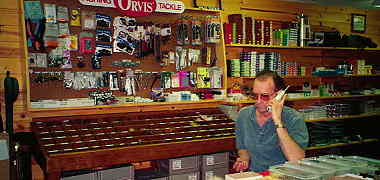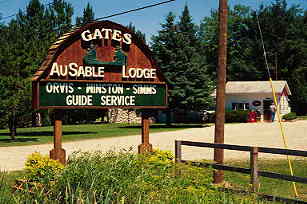|
What is 'quality water'? In some states it is known
as "Blue Ribbon," Montana uses that one - and rightly
so, since they have so much fine fly fishing water that it puts
many states to absolute shame.
And Montana, like many other states
which had fine fishing water, almost lost there's. When JC and
I first moved to Montana in the early 1970's, the daily possession
limit was 10 fish a day. Eventually that too changed, and some
streams are catch and release, while others have more reasonable
limits.

All stocking of Montana rivers and
streams stopped. So the fishery is totally relaint on
natural production. De-watering of streams has substantially
decreased
Those who have lived in regions where
the fishermen follow the stocking tank trucks know the
results on the native fish - if there are any left. As well
as the quality of the fisheries.
Besides intelligent regulations for
sustaining the fishery, there are other things that go into
producing quality water.
Establishing seasons in one of those things.
Many states have now opened trout fishing to be year round.
And if there are no spawning fish to be disturbed, and all fish
are "put-and-take" I suppose there is an arguement for that.

I personally disagree with the practice.
Even if the trout aren't spawning, other fish are. It also sends
the wrong message. That man is so important, and his need
to fish whenever and however he chooses, that states MUST
provide a open season to do that.

Horse pucky! Maybe we should be
teaching anglers who ought to know better how to respect
nature, not turn it into a disney experience.
Some states have mandated shore-line
protection zones. It can vary, but usually not less than 30 feet
from the waters edge, a green belt must be retained. There
will be exceptions to that, from pre-existing buildings. Over the
years, as building are replaced they will have to abide by the
green belts as well. But in the long view, the "feeling" of wilderness
where the green belts are in effect is remarkable.

Providing adequate places for launching or landing
personal watercraft devices or canoes is an important part of protecting
fragile rivers and stream banks. These 'landings' really do a dual job for
multi-purpose use. The streambanks are protected in a manner also
giving access.
 By the way, on the particular water shown in these
photos, there is also a committee that reviews any newly downed trees
into the river, and makes the decision as to whether they may be removed
or stay as "woody debris" for fish habitate. Just a small part of the story.
By the way, on the particular water shown in these
photos, there is also a committee that reviews any newly downed trees
into the river, and makes the decision as to whether they may be removed
or stay as "woody debris" for fish habitate. Just a small part of the story.

Here many miles downstream at the end
of the famous catch and release water, the "Holy Water" is
a canoe livery. Another noteable thing that can be done to
protect the stream is to severly restrict cement and rock docks
and bank bulkheading. The photo at the right an example of
how tastefully the restrictions can be a canoe livery on Michigan's
Au Sable river, just at the end of the "Holy Water."
Some 30 years ago the "Holy Water" did
not exist. This river was in big trouble. Fully mature brook trout
reproducing at six inches. Canoes out of control. Banks demolished,
major polution from failed septic systems. More recently, a series
of fires threatened the whole watershed.
Concerned anglers, along with some major
input from Trout Unlimited, lobbied the state legislature first for
reverse size limits, (catch and keep the small fish, release the larger
ones,) flies only water, and then for total catch and release on the
section of the Au Sable now known as the Holy Water. In time,
other rivers had at least sections of fly only water.
For the most part it has worked very
well. There are still canoes on the river, most however during
times that are not of real concern to the fly angler. I personally
would prefer if where were no recreational canoes on the
mainsteam of the Au Sable at all. But then, how can I possibly
justify floating along in a traditional Au Sable John Boat,
fishing my evening away.
So there has to be some kind of middle
ground. And a 'keeper' of the river. There have been a couple
'keepers' of the river over the years. None of them paid of course,
a couple that I knew are in their graves.
While JC and I were somewhat involved
in the recent Trout Bums "do" in Grayling which raised substantial
funds for restoration of the Au Sable and Manistee rivers, there
is another organization who is also watching the river very
carefully. It is the Anglers of the Au Sable.
The President of this group is Rusty Gates,
also know in that group as the "Inspirator of the Anglers." Rusty
lives on the river, and is ever vigilant, persevering, resolute, alert,
and practical.

Rusty and his brother Jim have the Gates
Lodge on the river. They make their living from the river - just
as their father did before. They have a vested interest in the
Au Sable.

But it is more than that.
There is in all those who are Anglers of the
Au Sable the pure, unabashed love for the river. For quality
water. For the places where fine trout are found.
Quality water perhaps is a state of mind.
It can be as real as the people who are willing to work and
fight to get or maintain the waters.
The Au Sable is not the only so-called
'quality water' in this country. It does happen to be a success
story of major importance. One others can use to pattern
the restoration of their waters. One to point a finger at and
say, "See, they did it!"
It may be a very small thing for me to
say Thank You! Thanks to all who fought the fight, and for
those still in the trenches fighting the battles as they rear their
ugly heads. Thanks for hard work, the physical work, the
phone calls, letters - for doing the everyday slogging stuff
it takes to be keepers of the river. And keepers of the
faith.
~Deanna Birkholm
|











